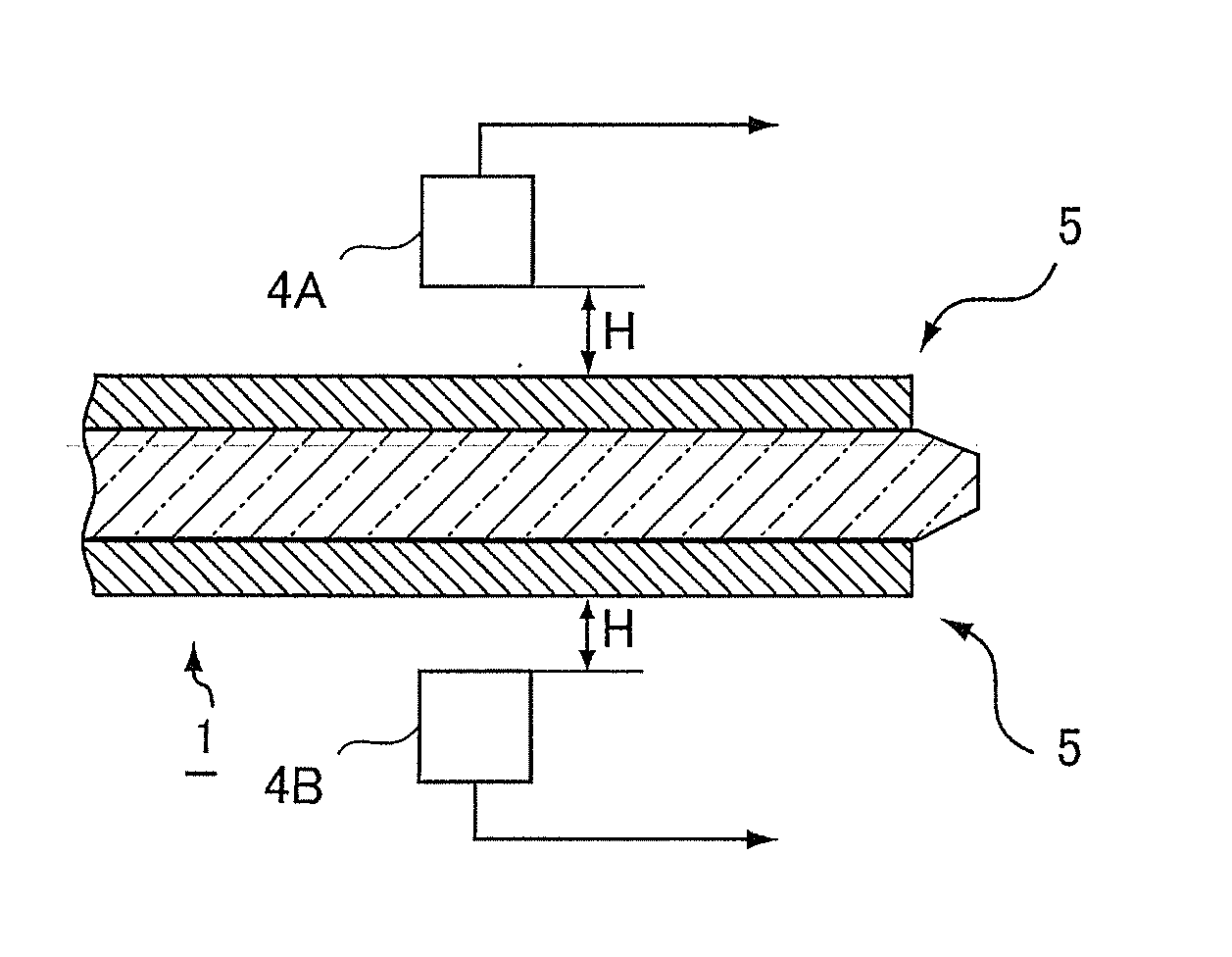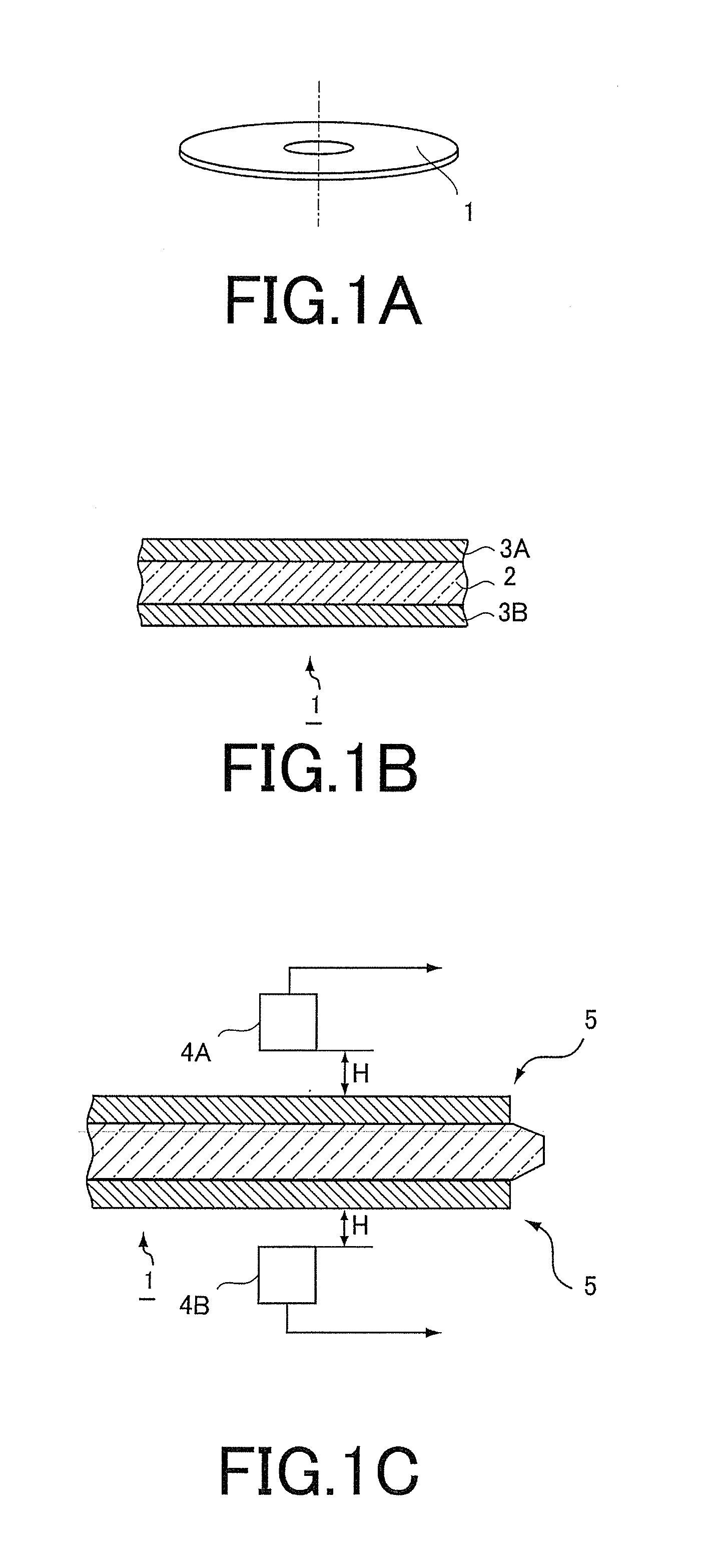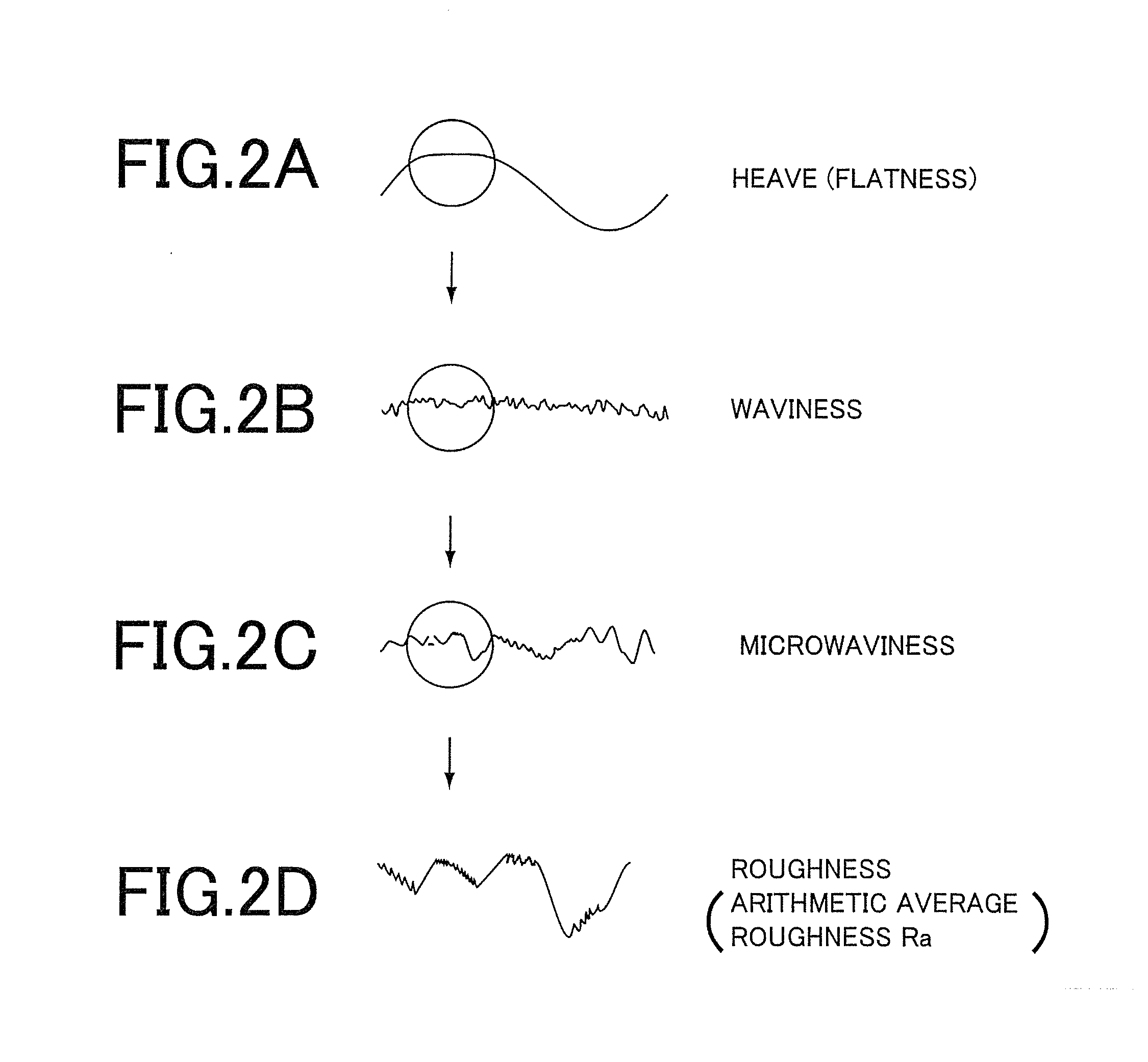Glass substrate for magnetic disk and manufacturing method thereof
a technology of glass substrate and magnetic disk, which is applied in the direction of magnetic materials for record carriers, manufacturing tools, instruments, etc., can solve the problems of insufficient surface irregularity accuracy of sheet glass material formed in accordance with the conventional method, and inability to achieve good flatness of sheet glass material formed, etc., to achieve good surface irregularity accuracy and impact resistance, and efficient manufacturing of glass substrate
Inactive Publication Date: 2011-06-30
HOYA CORP
View PDF15 Cites 64 Cited by
- Summary
- Abstract
- Description
- Claims
- Application Information
AI Technical Summary
Benefits of technology
[0020]Accordingly, the formed sheet glass material has the principal surface roughness of 0.01 or less and the target flatness of the glass substrate for magnetic disk. The thickness of the sheet glass material is larger than the target thickness of the glass substrate for magnetic disk by the polishing quantity of the glass substrate for magnetic disk. Because the sheet glass material obtained through the press forming step has the good surface irregularity accuracy, only the polishing process is performed to the sheet glass material in the surface treatment process, but the grinding process having the machining allowance larger than that of the polishing process is not performed to the principal surface. The good impact resistance is obtained by the compressive stress layer formed through the chemically strengthening process. Therefore, the glass substrate for magnetic disk having the good surface irregularity accuracy and impact resistance can efficiently be produced.
Problems solved by technology
The shortened floating distance of the magnetic head easily causes a head crush trouble or a thermal asperity trouble.
However, the surface irregularity of the sheet glass material formed in accordance with the conventional method is not sufficient for the surface irregularity accuracy of the principle surfaces for the high density of the magnetic recording and the fine magnetic recording information area.
The sheet glass material is easy to warp, and therefore good flatness of the formed sheet glass material is not achieved.
However, performing the grinding process becomes an additional process in the manufacturing of the glass substrate for magnetic disk, and further performing the grinding process caused a “roll-off problem”.
That is, a machining allowance (ground quantity) is increased in the grinding process because the flatness is not so good with the conventional press forming method.
When the machining allowance is increased in the grinding process, a deep crack is generated in the surface of the sheet glass material.
Therefore, in a polishing process subsequent to the grinding process, the machining allowance (polishing quantity) is inevitably increased such that the deep crack is not left.
Here, when the machining allowance is increased in the polishing process in which the loose abrasive grain and the resin polisher are used, the neighborhood in the outer circumferential edge portion is rounded in the principal surface of the sheet glass material to cause a “roll-off problem” of the edge portion.
As a result, the recording and reading operations of the magnetic head are not precisely performed in the magnetic layer in the neighborhood of the outer circumferential edge portion.
Because the sheet glass material having the sufficient flatness is not obtained with the conventional press forming method, it takes a relatively longer time to perform the grinding process that is the post-process, and then the “roll-off problem” is generated by the grinding process.
However, when the chemically strengthening process is performed to the extremely-high-flatness sheet glass material obtained by the floating method, unfortunately a warp is generated in the sheet glass material.
In summary, with the conventional press forming method, the grinding process is required because the sheet glass material having the sufficiently flatness is not obtained.
Method used
the structure of the environmentally friendly knitted fabric provided by the present invention; figure 2 Flow chart of the yarn wrapping machine for environmentally friendly knitted fabrics and storage devices; image 3 Is the parameter map of the yarn covering machine
View moreImage
Smart Image Click on the blue labels to locate them in the text.
Smart ImageViewing Examples
Examples
Experimental program
Comparison scheme
Effect test
examples 1 to 5
[0112]The glass substrate was prepared through Steps S20 to S70 illustrated in FIG. 3 using the sheet glass material having the principal surface flatness of 4 μm or less and the principal surface roughness ranging from 0.001 μm to 0.01 μm. The sheet glass material was formed by the press forming method illustrated in FIGS. 4 and 5.
the structure of the environmentally friendly knitted fabric provided by the present invention; figure 2 Flow chart of the yarn wrapping machine for environmentally friendly knitted fabrics and storage devices; image 3 Is the parameter map of the yarn covering machine
Login to View More PUM
| Property | Measurement | Unit |
|---|---|---|
| roughness | aaaaa | aaaaa |
| flatness | aaaaa | aaaaa |
| roughness | aaaaa | aaaaa |
Login to View More
Abstract
The present invention provides a method for efficiently manufacturing a glass substrate for magnetic disk having good accuracy of a surface irregularity and an impact resistance. The method includes the steps of: performing press forming to molten glass to prepare a sheet glass material, the sheet glass material having a roughness of the principal surface of 0.01 μm or less and target flatness of a glass substrate for magnetic disk; chemically strengthening the sheet glass material by dipping the sheet glass material in a chemically strengthening salt, thereby preparing a disk substrate; polishing the principal surfaces of the disk substrate. A thickness of the sheet glass material prepared in the press forming step is larger than a target thickness of the glass substrate for magnetic disk by a polishing quantity of the principal surface polishing step.
Description
CROSS-REFERENCE TO RELATED APPLICATION[0001]This application is based upon and claims the benefit of priority of the prior Japanese Patent Application No. 2009-299249, filed on Dec. 29, 2009, the entire contents of which are incorporated herein by reference.FIELD[0002]The present invention relates to a glass substrate for magnetic disk having a pair of principal surfaces and a manufacturing method thereof.BACKGROUND[0003]Recently, a hard disk device is incorporated in a personal computer, a notebook personal computer, and a DVD (Digital Versatile Disc) recording apparatus in order to record data. Particularly, in the hard disk device used in an apparatus such as the notebook personal computer based on portability, a magnetic disk in which a magnetic layer is provided on a glass substrate is used, and magnetic recording information is recorded in or read from a magnetic layer using a magnetic head (DFH (Dynamic Flying Height) head) that is slightly floated on a surface of the magneti...
Claims
the structure of the environmentally friendly knitted fabric provided by the present invention; figure 2 Flow chart of the yarn wrapping machine for environmentally friendly knitted fabrics and storage devices; image 3 Is the parameter map of the yarn covering machine
Login to View More Application Information
Patent Timeline
 Login to View More
Login to View More Patent Type & Authority Applications(United States)
IPC IPC(8): G11B5/70C03C21/00C03B11/00
CPCG11B5/8404B24B41/06C03B11/005C03B11/08G11B5/7315C03B11/088C03B11/05G11B5/735C03B11/125G11B5/73921
Inventor EDA, SHINJIISONO, HIDEKI
Owner HOYA CORP
Features
- R&D
- Intellectual Property
- Life Sciences
- Materials
- Tech Scout
Why Patsnap Eureka
- Unparalleled Data Quality
- Higher Quality Content
- 60% Fewer Hallucinations
Social media
Patsnap Eureka Blog
Learn More Browse by: Latest US Patents, China's latest patents, Technical Efficacy Thesaurus, Application Domain, Technology Topic, Popular Technical Reports.
© 2025 PatSnap. All rights reserved.Legal|Privacy policy|Modern Slavery Act Transparency Statement|Sitemap|About US| Contact US: help@patsnap.com



